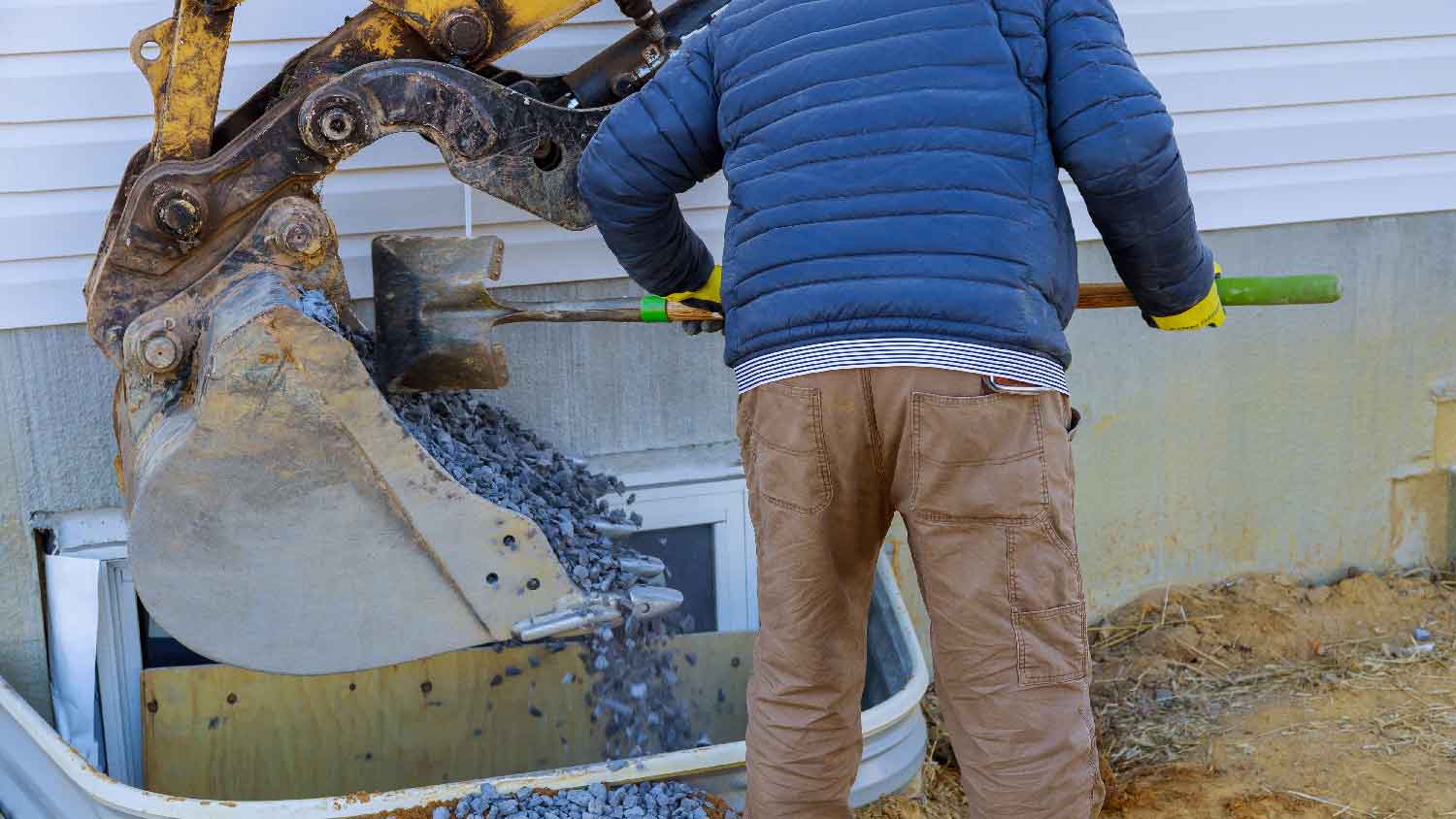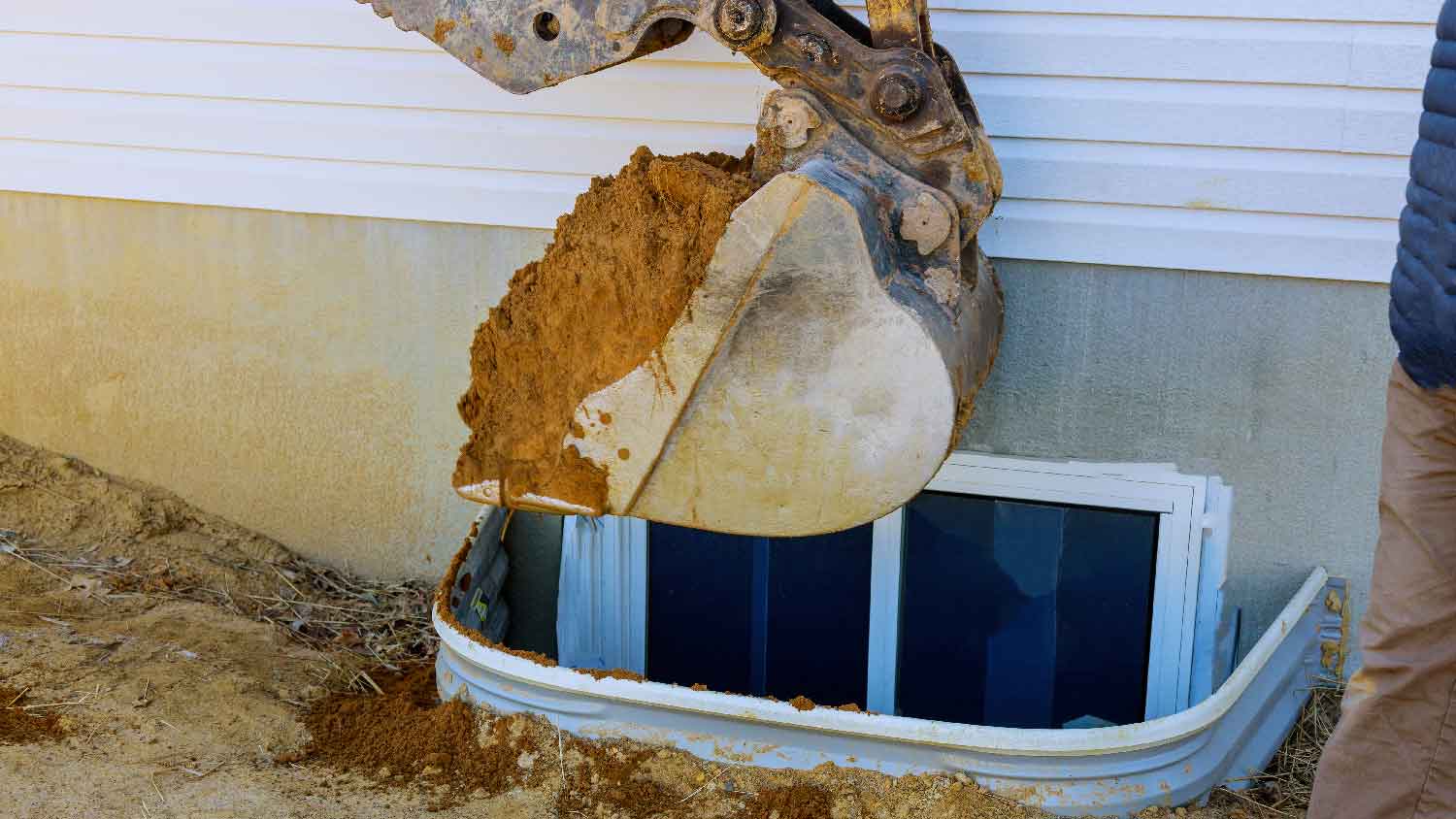How Much Does Window Well Replacement Cost? [2025 Data]
Window well replacement costs $2,200, on average, and most homeowners pay somewhere between $1,800 and $3,000, depending on the size, materials, location, and more.


Window well replacement costs an average of $2,200, but your total could fall anywhere between $1,800 and $3,000 depending on a few factors. Window wells are an invaluable addition to basements that can brighten up the space and act as an emergency exit. However, maintaining the window well is essential to avoid window leaks and foundation damage. In this guide, we’ll discuss the cost of window well replacement to help you budget for your project.
Window Well Replacement Cost Factors
Window well replacement costs can fall anywhere between $1,200 and $4,200 based on a few key factors that influence the total.
Materials
The materials you choose as a retaining wall will play a major role in your total replacement costs. The most common options are plastic, fiberglass, steel, and concrete. Plastic is the most affordable option when it comes to materials, costing an average of $800, while custom concrete retaining walls can bring your materials cost to $2,500 or more.
It’s important to choose the right material for your area, as it will act as the primary defense against expanding soil and rainwater. You should also consider the appearance of the material you pick, as it’s what will be visible directly outside your basement windows.
| Material | Typical Cost |
|---|---|
| Plastic | $700 – $1,000 |
| Steel | $800 – $1,800 |
| Fiberglass | $1,000 – $2,200 |
| Concrete | $1,500 – $2,800 |
Labor
You can expect around 50%, or an average of $900 to $1,500, of your total window well replacement cost to go toward labor. The labor includes removing your old window well, excavating the area if necessary, and installing the new material.
Labor costs can sit as low as around $500 for a simple one-to-one replacement, but they can climb up to about $1,500 if you need your installer to build a custom concrete window well.
Window Well Size
The sizes of both your old window well and the new one will play a big part in your replacement costs. The larger your window well, the more you’ll pay for both materials and labor. You can expect to pay between $500 and $1,000 or more for excavation if you’re making your window well larger. Otherwise, the required excavation is included in the labor cost.
Permits
Most municipalities have strict requirements regarding both the size and type of the egress window installed in your window well, as well as the size and location of the window well itself. Your building department ensures that all requirements are met by requiring permits for window well installation and replacement.
Permits cost between $50 and $100 for window well replacement in most cases, although prices can climb as high as $300 in some areas.
Location
The location of the window well on your property will affect your costs because it dictates how easy it is for your professionals to access the area. A window well in a tight spot between your house and a landscaping feature, like a deck or fence, can make it more difficult to access with the excavation machinery. If your installers need to dig using manual tools, it will take longer and cost a few hundred more.
Additionally, your professionals will need to remove the old window well material. For single-piece window wells, like those made of plastic, fiberglass, or steel, the location won’t have much impact. But if you’re replacing an old concrete window well, your labor costs can go up by between $100 and $300 if the removal and haul away is more difficult because of the window location.
Debris Removal
Some professionals will include debris removal in their estimates, while others charge extra for haul-away services and dumping fees. This accounts for just a small part of your total, often around $50, but you might be on the hook for dumping fees totaling up to $300 or more for disposing of large concrete window wells.
Window Well Replacement Ongoing Expenses

Window wells sit below the ground and tirelessly work to keep water and other debris away from your basement window. You should budget for ongoing repairs and maintenance to ensure they’re functioning properly.
Repairs
On occasion, you might need to pay for window well repairs, typically only if you have a concrete window well. These last for decades in most cases, but you might need to patch cracks or leaks during their life span to keep water away from your foundation. Concrete repair costs between $3 and $9 per square foot, but travel, trip fees, and labor will bring your repair total to between $150 and $300.
Maintenance
Window wells require minimal maintenance, but you may need to pay between $50 and $100 to clear the window well drain if you have one. You can do this as needed, and the frequency will largely depend on whether you have window well covers installed and the number of trees in your yard that drop leaves and other debris that can cause clogs.
Luckily, you can clear a window well drain as a simple DIY project, so you can save some money over time by doing the work yourself.
DIY Window Well Replacement vs. Hiring a Pro
It’s possible to replace a window well yourself, and you could save between $900 and $1,500 if you DIY the work. However, it’s best to hire a professional and pay the money to have the job done correctly.
Replacing a window well involves excavation near your foundation, which can cause structural damage if you do it incorrectly. Additionally, most window wells also attach to your concrete foundation, and many tie into an underground drainage system. The work is complicated, and any mistakes during the replacement can increase your risk of foundation leaks, water intrusion, and damage to different parts of your window.
We strongly recommend leaving the work to a window company near you to avoid damaging your home and prevent additional problems down the road.
Cost of Common Window Well Add-Ons
There are three main add-on services you can choose when replacing your window well, all of which will have an impact on your total replacement cost.
Window Replacement
In many cases, homeowners replace their window wells when they have an issue with the old well or a leak in the window inside the well, so you might need to budget for window replacement costs in addition to the actual well.
Window replacement costs an average of $850, but you could pay anywhere between $100 and $1,000 or more for this portion of the job. The total depends on the size and type of window, as well as frame and glass materials.
| Type of Window | Replacement Cost |
|---|---|
| Picture window | $65 to $700 |
| Single-hung window | $100 to $400 |
| Double-hung window | $150 to $650 |
| Casement window | $150 to $1,000 |
Window Well Cover Installation
Window well covers keep leaves and other debris out of your window well, but many are clear and will still let light pass through to brighten up your basement. You can expect to pay between $70 and $700 per window well cover for the materials and labor to install them, largely depending on the material you choose and whether or not you want custom designs.
| Cover Material | Typical Cost |
|---|---|
| Plastic | $70 to $200 |
| Polycarbonate | $200 to $300 |
| Metal | $300 to $700 |
| Custom | $500 to $1,000 |
Adding Drainage
Some window wells aren’t connected to an underground drainage system. Instead, they have a base of gravel or crushed stone to collect runoff and let it drain naturally into the soil below. If you’ve run into window well drainage problems in the past, you might want to have your window contractor connect the window well to an existing drainage system, like a French drain or an interior sump pump.
Connecting your window well to a drainage system will add between $500 and $1,000 in labor and material costs. However, this price could increase significantly depending on how close your window well is to an existing drainage system.
How To Save Money on Window Well Replacement

Window well replacement can get expensive, but there are a few things you can do to help keep your costs down.
Choose your material carefully. Opting for a plastic window well over a custom concrete one can save you over $1,000 on the cost of installing a window well, on average. Plastic won’t last as long and may not look as nice, but if you’re on a tight budget, choosing more affordable materials is a great way to save.
Keep your window well the same size. You’ll spend between $500 and $1,000 on additional excavation to enlarge your window well. Keep your new well the same size and shape as the old one to keep your costs low.
Choose natural drainage. Connecting to a drainage system might be a good idea and even necessary based on your location and climate. If you speak with your professional about the option and deem it unnecessary, you can save another $500 to $1,000 by opting for natural drainage, like partially filling the well with gravel.
Haul away debris yourself. You can save between $50 and $300 by hauling away the old window well material yourself. You might still be on the hook for dumping fees, but they’ll almost always be lower than paying your professional to remove and dump the material.
Frequently Asked Questions
The most obvious sign that you need to replace your window well is if you have ongoing issues with leaks in the window itself. Window wells should keep water and debris away from your basement window, so problems with water intrusion could indicate that the window well is no longer doing its job. In some cases, this is an indication that you need a window well drainage system, which is a great opportunity to replace the entire well. Other signs include rusting on metal window wells or cracking in concrete, plastic, or fiberglass window wells.
The best and most permanent way to fix water in a window well is to connect your window well to an existing drainage system, like an interior sump pump or an exterior French drain. Doing so will allow water that would otherwise collect in the well to drain to a safe spot on your property. If you’re just dealing with small amounts of water in your well, you might be able to get away with just installing window well covers. These are far more affordable, although they won’t solve the problem of water coming through cracks in the window well itself.
No, some window wells aren’t connected to drainage systems and instead are partially filled with gravel or crushed stone. In that case, water entering the well will drip down through the stone and disperse into the soil below. Window well drains might be required in areas with heavy rainfall or expansive soil—the lack of them could lead to foundation damage without a proper drainage system.
Most professionals can install a window well in two to three days, depending on the size of the well and the window you want inside it. If you’re just replacing an existing window well, the work is much less intensive, and most experts can get the job done in just one day. Connecting the window well to a drainage system or installing a custom concrete window well will naturally take longer, but even the most complicated installations shouldn’t take more than three days.















